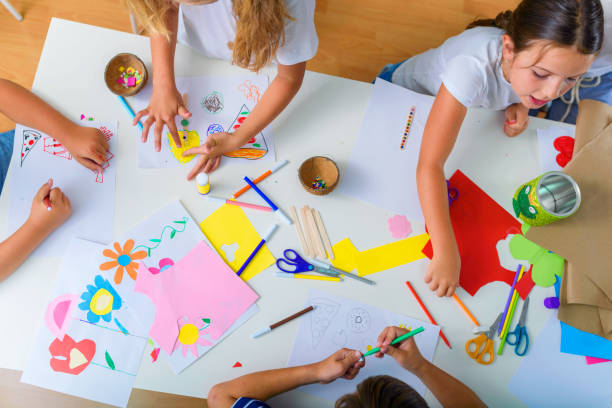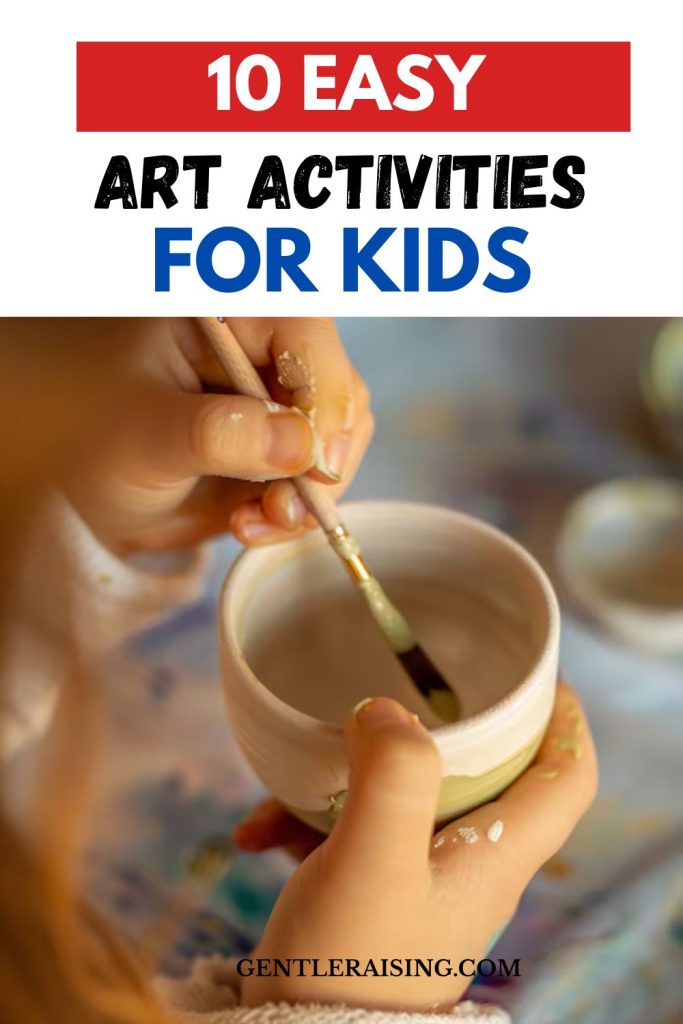If your toddler’s got marker on their nose, paint in their hair, and glitter stuck between their toes… you’re doing it right.
Art with kids isn’t about perfection. It’s about imagination. It’s about connection. It’s about pausing the chaos of parenting for just long enough to say, “Hey, let’s make something weird and wonderful together.”
So whether you’re a seasoned crafter or someone who breaks into hives just hearing the word “glue,” this guide’s for you. We’re keeping it simple, joyful, and 100% judgment-free. Let’s explore the colourful world of kids’ art activities, without losing our minds.
Why Art (Really) Matters for Kids, and Parents
Let’s start here: kids need art.
Not just for fun (though that matters too), but because art builds brains. When a child scribbles, splashes, cuts, and glues, they’re practising:
- Fine motor control
- Decision-making
- Creative thinking
- Emotional expression
- Sensory processing
- Patience (yes, even that)
But here’s what often gets overlooked: you need art, too.
Parents, especially moms, spend so much time directing, teaching, and correcting. But art invites us to just be. No rules. No pressure. Just a paper, a crayon, and a shared giggle.
And don’t worry. Pinterest-perfect isn’t the goal. Real-life art is lumpy, sticky, wildly colourful, and often sideways. That’s the magic.
Starting Small (Because You’ve Got Laundry to Fold)
You don’t need a cart full of craft supplies or a dedicated art room (though if you have one, jealous). Here’s your down-to-earth starter list:
Basic Art Supplies for Toddlers and Preschoolers
- Washable markers (Crayola and Ooly are great)
- Non-toxic paints (tempera watercolours)
- Fat crayons (easier to grip for little hands)
- Glue sticks (less messy than liquid glue)
- Kid-safe scissors (start with blunt tips)
- Recycled paper, cereal boxes, cardboard tubes
- A drop cloth or old sheet (for your peace of mind)
Pro tip: Put everything in a basket labelled “Art Time.” That way, when your kid asks, you don’t have to hunt down supplies during nap time.
Messy, Magical Art Ideas to Try Today
1. Finger Painting Freedom
It’s messy. It’s chaotic. It’s brilliant.
Squeeze blobs of primary colours onto a plastic tray. Tape down a big sheet of paper. Let them go wild. Bonus tip? Add a few drops of dish soap to the paint; it makes cleanup easier and creates a smooth glide.
Feeling brave? Strip them down to a diaper or undies and let them finger paint outdoors.
2. Sticker Collage (aka 5-Minute Quiet Time)
Peel. Stick. Repeat. It’s oddly satisfying for you and your toddler.
Use old magazines, sticker books from the dollar store, or those leftover address labels you’ll never use. Let your child layer and build their abstract masterpieces.
No glue. No rules. Just peaceful silence for a few minutes (we know how rare that is).
3. Nature Collage Treasure Hunt
Take a walk. Collect leaves, grass, flowers, and small sticks. Then come home and turn the kitchen table into a nature studio.
Tape, glue, or press your finds onto paper. Add marker doodles, crayon outlines, or even googly eyes. Boom, natural magic.
This one doubles as a mini science lesson and encourages observation.
4. Play-Dough Sculpting Session
Store-bought or homemade, play-dough is a toddler’s tactile wonderland.
Make simple shapes, snakes, pizzas, and dinosaurs. Or go off-script and build something wild. Add small objects like buttons or plastic animals for imaginative play.
Need a homemade dough recipe? Mix 2 cups of flour, 1 cup salt, 1 tbsp cream of tartar, 2 tbsp oil, 1.5 cups hot water, and food colouring. Stir and knead. Done.
5. Recycled Robot Building
Raid your recycling bin, cereal boxes, egg cartons, bottle caps, paper towel tubes—and let your kid build a robot (or a spaceship, or a castle).
Glue pieces together, decorate with markers or foil, and give it a name. This taps into engineering, storytelling, and problem-solving, all wrapped in fun.
Add a Seasonal Twist: Art All Year Long
Art gets a little extra magical when you tie it to the seasons. Here’s how to keep creativity flowing month by month:
Spring:
- Paint with flower petals
- Draw raindrop patterns with watercolours
- Use cookie cutters and paint to stamp spring shapes
Summer:
- Try “sun prints” with construction paper and leaves
- Paint with ice cubes (just freeze colored water with popsicle sticks)
- Make beach collages with sand, shells, and paper
Fall:
- Leaf rubbings using crayons and real leaves
- Pumpkin stamping with halved apples
- Handprint turkeys (you knew that one was coming)
Winter:
- Glue cotton balls to make snow scenes
- Paper snowflakes (yes, toddlers can help tear!)
- Make ornaments with salt dough
Seasonal art builds awareness of time and weather, plus, it gives you sweet keepsakes to hang up or gift to grandparents.
When You Want Structure: Low-Effort, High-Impact
Some days, kids need freedom. Other days, they’re looking at you like, “What now, Mom?”
Here are ways to add structure without stress:
- “Draw along” YouTube videos like Art for Kids Hub
- Activity books with traceable shapes or colour-by-number pages
- Sensory art kits from brands like KiwiCo or Lovevery
- Theme days like “Under the Sea” (paint fish), “Outer Space” (glue stars), or “Feelings Friday” (draw faces)
Give a prompt, then let them interpret it however they want. The result? Confidence + creativity.
Art Time = Growth Time (Even When It Looks Like Chaos)
Here’s what’s happening beneath all that glitter and paint:
- Building fine motor skills with every brush stroke and scissor snip
- Boosting emotional expression, especially helpful for toddlers who can’t always name their feelings
- Strengthening focus and practising patience
- Encouraging imagination with open-ended prompts
- Creating emotional bonds through shared projects
And when you praise the process, not the result (“I love how you used blue in that sky!”), You teach resilience, curiosity, and the joy of effort.
What About the Meltdowns? (Because They’ll Happen)
Let’s be honest: not every art session ends in sunshine.
Sometimes the paint spills. The glue sticks to the dog. Your toddler screams because their elephant looks “too much like a dog.”
It’s fine.
Here’s how to handle it:
- Keep expectations low; the goal is exploration, not a gallery show
- Take breaks when frustration bubbles up
- Use washable everything to avoid stress
- Set up a “yes” space, an art tray or corner, where mess is welcome
- Laugh it off when things go sideways (because they will)
Art with kids teaches us patience, too.
Wrapping It Up (With a Glitter Bow)
If you’ve made it this far, you already get it: art is more than crafts. It’s memory-making. It’s emotional glue. It’s an excuse to pause and play before bedtime.
So don’t overthink it. Give your kids paper and paint. Sit beside them. Smudge some colours. Ask questions like “Tell me about this part,” or “How did you think of that?”
And when they run off halfway through, leaving a sticky trail behind, just smile. Because e those little handprints on the table? They’re the good kind of mess.
Quick Bonus: 12 No-Prep Art Ideas for Busy Parents
Need a 2-minute setup? Bookmark this list:
- Crayon on cardboard
- Q-tip pointillism
- Chalk on black paper
- Dot marker designs
- Washi tape abstract art
- Sponge painting
- Magazine face mashups
- Water painting on the sidewalk
- Collage with scraps
- Bubble wrap prints
- Potato stamps
- Drawing on steamed-up windows
Final Thought
Art isn’t about being perfect. It’s about being present. So let your kid colour outside the lines. You might just find a little more joy outside them, too.

